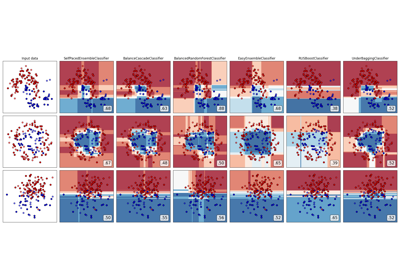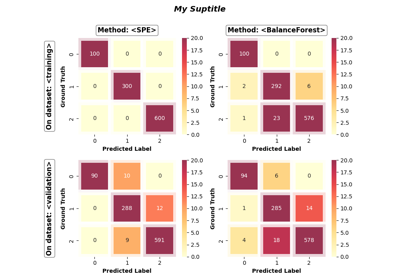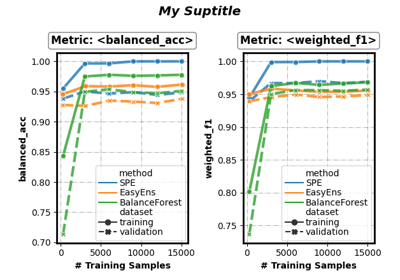EasyEnsembleClassifier
- class imbens.ensemble.EasyEnsembleClassifier(estimator=None, n_estimators: int = 50, *, max_samples=1.0, max_features=1.0, bootstrap=True, bootstrap_features=False, oob_score=False, warm_start=False, n_jobs=None, random_state=None, verbose=0)[source]
Bag of balanced boosted learners also known as EasyEnsemble.
This algorithm is known as EasyEnsemble [1]. The classifier is an ensemble of AdaBoost learners trained on different balanced boostrap samples. The balancing is achieved by random under-sampling.
This implementation extends EasyEnsemble to support multi-class classification.
- Parameters:
- n_estimatorsint, default=50
Number of AdaBoost learners in the ensemble.
- estimatorestimator object, default=AdaBoostClassifier(n_estimators=10)
The base AdaBoost classifier used in the inner ensemble. Note that you can use another classifier as the base estimator, but this will degrades EasyEnsemble to
UnderBaggingClassifierand raise a Warning.- max_samplesint or float, default=1.0
The number of samples to draw from X to train each base estimator (with replacement by default, see bootstrap for more details).
If
int, then draw max_samples samples.If
float, then draw max_samples * X.shape[0] samples.
- max_featuresint or float, default=1.0
The number of features to draw from X to train each base estimator ( without replacement by default, see bootstrap_features for more details).
If
int, then draw max_features features.If
float, then draw max_features * X.shape[1] features.
- bootstrapbool, default=True
Whether samples are drawn with replacement. If False, sampling without replacement is performed.
- bootstrap_featuresbool, default=False
Whether features are drawn with replacement.
- oob_scorebool, default=False
Whether to use out-of-bag samples to estimate the generalization error.
- warm_startbool, default=False
When set to True, reuse the solution of the previous call to fit and add more estimators to the ensemble, otherwise, just fit a whole new ensemble. See Glossary for more details.
- n_jobsint, default=None
The number of jobs to run in parallel for both
fit()andpredict().Nonemeans 1 unless in ajoblib.parallel_backendcontext.-1means using all processors. See Glossary for more details.- random_stateint, RandomState instance or None, default=None
Control the randomization of the algorithm. Within each iteration, a different seed is generated for each sampler. If the base estimator accepts a random_state attribute, a different seed is generated for each instance in the ensemble. Pass an
intfor reproducible output across multiple function calls.If
int,random_stateis the seed used by the random number generator;If
RandomStateinstance, random_state is the random number generator;If
None, the random number generator is theRandomStateinstance used bynp.random.
- verboseint, default=0
Controls the verbosity when fitting and predicting.
- Attributes:
- estimator_pipeline estimator
The base estimator from which the ensemble is grown.
- sampler_RandomUnderSampler
The base sampler.
- estimators_list of classifiers
The collection of fitted sub-estimators.
- n_features_in_int
The number of features when
fit()is performed.- estimators_list of estimators
The collection of fitted base estimators.
estimators_samples_list of arraysThe subset of drawn samples for each base estimator.
- estimators_features_list of arrays
The subset of drawn features for each base estimator.
- estimators_n_training_samples_list of ints
The number of training samples for each fitted base estimators.
- classes_ndarray of shape (n_classes,)
The classes labels.
- n_classes_int or list
The number of classes.
- oob_score_float
Score of the training dataset obtained using an out-of-bag estimate. This attribute exists only when
oob_scoreis True.- oob_decision_function_ndarray of shape (n_samples, n_classes)
Decision function computed with out-of-bag estimate on the training set. If n_estimators is small it might be possible that a data point was never left out during the bootstrap. In this case, oob_decision_function_ might contain NaN. This attribute exists only when
oob_scoreis True.
See also
BalanceCascadeClassifierEnsemble with cascade dynamic under-sampling.
SelfPacedEnsembleClassifierEnsemble with self-paced dynamic under-sampling.
UnderBaggingClassifierBagging with intergrated random under-sampling.
References
[1]X. Y. Liu, J. Wu and Z. H. Zhou, “Exploratory Undersampling for Class-Imbalance Learning,” in IEEE Transactions on Systems, Man, and Cybernetics, Part B (Cybernetics), vol. 39, no. 2, pp. 539-550, April 2009.
Examples
>>> from imbens.ensemble import EasyEnsembleClassifier >>> from sklearn.datasets import make_classification >>> >>> X, y = make_classification(n_samples=1000, n_classes=3, ... n_informative=4, weights=[0.2, 0.3, 0.5], ... random_state=0) >>> clf = EasyEnsembleClassifier(random_state=0) >>> clf.fit(X, y) EasyEnsembleClassifier(...) >>> clf.predict(X) array([...])
Methods
Average of the decision functions of the base classifiers.
fit(X, y, *[, sample_weight, max_samples, ...])Build an EasyEnsemble classifier from the training set (X, y).
Get metadata routing of this object.
get_params([deep])Get parameters for this estimator.
predict(X)Predict class for X.
Predict class log-probabilities for X.
Predict class probabilities for X.
score(X, y[, sample_weight])Return the mean accuracy on the given test data and labels.
set_fit_request(*[, eval_datasets, ...])Request metadata passed to the
fitmethod.set_params(**params)Set the parameters of this estimator.
set_score_request(*[, sample_weight])Request metadata passed to the
scoremethod.- property base_estimator_
Estimator used to grow the ensemble.
- decision_function(X)[source]
Average of the decision functions of the base classifiers.
- Parameters:
- X{array-like, sparse matrix} of shape (n_samples, n_features)
The training input samples. Sparse matrices are accepted only if they are supported by the base estimator.
- Returns:
- scorendarray of shape (n_samples, k)
The decision function of the input samples. The columns correspond to the classes in sorted order, as they appear in the attribute
classes_. Regression and binary classification are special cases withk == 1, otherwisek==n_classes.
- property estimators_samples_
The subset of drawn samples for each base estimator.
Returns a dynamically generated list of indices identifying the samples used for fitting each member of the ensemble, i.e., the in-bag samples.
Note: the list is re-created at each call to the property in order to reduce the object memory footprint by not storing the sampling data. Thus fetching the property may be slower than expected.
- fit(X, y, *, sample_weight=None, max_samples=None, eval_datasets: dict = None, eval_metrics: dict = None, train_verbose: bool = False)[source]
Build an EasyEnsemble classifier from the training set (X, y).
- Parameters:
- X{array-like, sparse matrix} of shape (n_samples, n_features)
The training input samples. Sparse matrix can be CSC, CSR, COO, DOK, or LIL. DOK and LIL are converted to CSR.
- yarray-like of shape (n_samples,)
The target values (class labels).
- sample_weightarray-like of shape (n_samples,), default=None
Sample weights. If None, the sample weights are initialized to
1 / n_samples.- max_samplesint or float, default=None
Argument to use instead of self.max_samples.
- eval_datasetsdict, default=None
Dataset(s) used for evaluation during the ensemble training process. The keys should be strings corresponding to evaluation datasets’ names. The values should be tuples corresponding to the input samples and target values.
Example:
eval_datasets = {'valid' : (X_valid, y_valid)}- eval_metricsdict, default=None
Metric(s) used for evaluation during the ensemble training process.
If
None, use 3 default metrics:'acc':sklearn.metrics.accuracy_score()'balanced_acc':sklearn.metrics.balanced_accuracy_score()'weighted_f1':sklearn.metrics.f1_score(average='weighted')
If
dict, the keys should be strings corresponding to evaluation metrics’ names. The values should be tuples corresponding to the metric function (callable) and additional kwargs (dict).The metric function should at least take 2 named/keyword arguments,
y_trueand one of [y_pred,y_score], and returns a float as the evaluation score. Keyword arguments:y_true, 1d-array of shape (n_samples,), true labels or binary label indicators corresponds to ground truth (correct) labels.When using
y_pred, input will be 1d-array of shape (n_samples,) corresponds to predicted labels, as returned by a classifier.When using
y_score, input will be 2d-array of shape (n_samples, n_classes,) corresponds to probability estimates provided by the predict_proba method. In addition, the order of the class scores must correspond to the order oflabels, if provided in the metric function, or else to the numerical or lexicographical order of the labels iny_true.
The metric additional kwargs should be a dictionary that specifies the additional arguments that need to be passed into the metric function.
Example:
{'weighted_f1': (sklearn.metrics.f1_score, {'average': 'weighted'})}- train_verbosebool, default=False
Controls the verbosity during ensemble training/fitting.
False: disable training verbose.True: print the performance score to sys.stdout after the parallel training finished.
- Returns:
- selfobject
- get_metadata_routing()[source]
Get metadata routing of this object.
Please check User Guide on how the routing mechanism works.
- Returns:
- routingMetadataRequest
A
MetadataRequestencapsulating routing information.
- get_params(deep=True)[source]
Get parameters for this estimator.
- Parameters:
- deepbool, default=True
If True, will return the parameters for this estimator and contained subobjects that are estimators.
- Returns:
- paramsdict
Parameter names mapped to their values.
- predict(X)[source]
Predict class for X.
The predicted class of an input sample is computed as the class with the highest mean predicted probability. If base estimators do not implement a
predict_probamethod, then it resorts to voting.- Parameters:
- X{array-like, sparse matrix} of shape (n_samples, n_features)
The training input samples. Sparse matrices are accepted only if they are supported by the base estimator.
- Returns:
- yndarray of shape (n_samples,)
The predicted classes.
- predict_log_proba(X)[source]
Predict class log-probabilities for X.
The predicted class log-probabilities of an input sample is computed as the log of the mean predicted class probabilities of the base estimators in the ensemble.
- Parameters:
- X{array-like, sparse matrix} of shape (n_samples, n_features)
The training input samples. Sparse matrices are accepted only if they are supported by the base estimator.
- Returns:
- pndarray of shape (n_samples, n_classes)
The class log-probabilities of the input samples. The order of the classes corresponds to that in the attribute classes_.
- predict_proba(X)[source]
Predict class probabilities for X.
The predicted class probabilities of an input sample is computed as the mean predicted class probabilities of the base estimators in the ensemble. If base estimators do not implement a
predict_probamethod, then it resorts to voting and the predicted class probabilities of an input sample represents the proportion of estimators predicting each class.- Parameters:
- X{array-like, sparse matrix} of shape (n_samples, n_features)
The training input samples. Sparse matrices are accepted only if they are supported by the base estimator.
- Returns:
- pndarray of shape (n_samples, n_classes)
The class probabilities of the input samples. The order of the classes corresponds to that in the attribute classes_.
- score(X, y, sample_weight=None)[source]
Return the mean accuracy on the given test data and labels.
In multi-label classification, this is the subset accuracy which is a harsh metric since you require for each sample that each label set be correctly predicted.
- Parameters:
- Xarray-like of shape (n_samples, n_features)
Test samples.
- yarray-like of shape (n_samples,) or (n_samples, n_outputs)
True labels for X.
- sample_weightarray-like of shape (n_samples,), default=None
Sample weights.
- Returns:
- scorefloat
Mean accuracy of
self.predict(X)w.r.t. y.
- set_fit_request(*, eval_datasets: bool | None | str = '$UNCHANGED$', eval_metrics: bool | None | str = '$UNCHANGED$', max_samples: bool | None | str = '$UNCHANGED$', sample_weight: bool | None | str = '$UNCHANGED$', train_verbose: bool | None | str = '$UNCHANGED$') EasyEnsembleClassifier[source]
Request metadata passed to the
fitmethod.Note that this method is only relevant if
enable_metadata_routing=True(seesklearn.set_config()). Please see User Guide on how the routing mechanism works.The options for each parameter are:
True: metadata is requested, and passed tofitif provided. The request is ignored if metadata is not provided.False: metadata is not requested and the meta-estimator will not pass it tofit.None: metadata is not requested, and the meta-estimator will raise an error if the user provides it.str: metadata should be passed to the meta-estimator with this given alias instead of the original name.
The default (
sklearn.utils.metadata_routing.UNCHANGED) retains the existing request. This allows you to change the request for some parameters and not others.New in version 1.3.
Note
This method is only relevant if this estimator is used as a sub-estimator of a meta-estimator, e.g. used inside a
pipeline.Pipeline. Otherwise it has no effect.- Parameters:
- eval_datasetsstr, True, False, or None, default=sklearn.utils.metadata_routing.UNCHANGED
Metadata routing for
eval_datasetsparameter infit.- eval_metricsstr, True, False, or None, default=sklearn.utils.metadata_routing.UNCHANGED
Metadata routing for
eval_metricsparameter infit.- max_samplesstr, True, False, or None, default=sklearn.utils.metadata_routing.UNCHANGED
Metadata routing for
max_samplesparameter infit.- sample_weightstr, True, False, or None, default=sklearn.utils.metadata_routing.UNCHANGED
Metadata routing for
sample_weightparameter infit.- train_verbosestr, True, False, or None, default=sklearn.utils.metadata_routing.UNCHANGED
Metadata routing for
train_verboseparameter infit.
- Returns:
- selfobject
The updated object.
- set_params(**params)[source]
Set the parameters of this estimator.
The method works on simple estimators as well as on nested objects (such as
Pipeline). The latter have parameters of the form<component>__<parameter>so that it’s possible to update each component of a nested object.- Parameters:
- **paramsdict
Estimator parameters.
- Returns:
- selfestimator instance
Estimator instance.
- set_score_request(*, sample_weight: bool | None | str = '$UNCHANGED$') EasyEnsembleClassifier[source]
Request metadata passed to the
scoremethod.Note that this method is only relevant if
enable_metadata_routing=True(seesklearn.set_config()). Please see User Guide on how the routing mechanism works.The options for each parameter are:
True: metadata is requested, and passed toscoreif provided. The request is ignored if metadata is not provided.False: metadata is not requested and the meta-estimator will not pass it toscore.None: metadata is not requested, and the meta-estimator will raise an error if the user provides it.str: metadata should be passed to the meta-estimator with this given alias instead of the original name.
The default (
sklearn.utils.metadata_routing.UNCHANGED) retains the existing request. This allows you to change the request for some parameters and not others.New in version 1.3.
Note
This method is only relevant if this estimator is used as a sub-estimator of a meta-estimator, e.g. used inside a
pipeline.Pipeline. Otherwise it has no effect.- Parameters:
- sample_weightstr, True, False, or None, default=sklearn.utils.metadata_routing.UNCHANGED
Metadata routing for
sample_weightparameter inscore.
- Returns:
- selfobject
The updated object.


